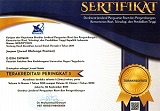TERAPI LATIHAN FISIK SEBAGAI TATALAKSANA CEDERA SPRAIN PERGELANGAN KAKI BERULANG: LAPORAN KASUS
DOI:
https://doi.org/10.21831/jorpres.v13i2.25104Keywords:
ankle sprain, exercise therap, recurrent injury, prevention program, terapi latihan fisik, cedera berulang, program pencegahanAbstract
Ankle sprain is a common injury that often occurs during exercise. Clinicians have been seeking various ways to deal with this injury. There are a variety of treatment options and strategies to manage this health issues in patients. However, the most effective therapy in these injuries still has not be determined.
Firstable, by determining the research question: "Which is the most appropriate therapy for an ankle sprain injury?" Then conducted a systematic review to gather the latest scientific evidence in order to help in choosing the appropriate the treatment and prevention of ankle sprain injury. Obtained two manuscripts that discuss the similar issue, entitled "Intervention for Increasing Ankle Theurapetic Dorsoflexion After Ankle sprain: A Systematic Review" and "National Athletic Trainers' Associations Position Statement: Conservative Management and Prevention of Ankle sprains in Athletes". In the manuscript describes a combination of stretching exercises, strength training, exercise therapy propioception in exercise is the most effective procedures on managing and preventing recurrent ankle sprains.
We can conclude that the treatment of choice based on scientific searches in ankle sprain injury patients is exercise therapy. However, it should be noted on the prescription of exercise will vary according to the conditions and circumstances of each patients.
ABSTRAK
Cedera sprain pada pergelangan kaki merupakan cedera yang sering terjadi pada saat melakukan latihan fisik. Para klinisi telah mengupayakan berbagai metode tatalaksana untuk menangani cedera ini. Terdapat keanekaragaman pilihan terapi dan strategi penanganan masalah kesehatan pada pasien dengan keluhan nyeri pada pergelangan pasien. Namun demikian, kombinasi ataupun pilihan terapi yang paling efektif pada cedera ini masih belum dapat ditentukan secara pasti.
Langkah pertama yang dilakukan adalah menentukan pertanyaan penelitian, yaitu: "Jenis terapi pilihan apakah yang sesuai untuk cedera sprain pergelangan kaki?" Kemudian dilakukan systematic review untuk mengumpulkan bukti-bukti ilmiah terbaru agar membantu menjelaskan tatalaksana dan pencegahan cedera sprain pergelangan kaki. Didapatkan 2 manuskrip yang membahas isu yang hampir serupa dengan berjudul "Theurapetic Intervention for Increasing Ankle Dorsoflexion After Ankle Sprain: A Systematic Review" dan "National Athletic Trainers' Associations Position Statement: Conservative Management and Prevention of Ankle Sprains in Athletes". Pada manuskrip tersebut menjabarkan kombinasi latihan peregangan, latihan kekuatan, latihan propioseptif dalam terapi latihan fisik sebagai prosedur tatalaksana dan pencegahan cedera sprain pergelangan kaki berulang yang paling efektif. Dapat disimpulkan terapi pilihan berdasarkan penelusuran ilmiah pada pasien dengan keluhan cedera sprain pada pergelangan kaki adalah terapi latihan fisik. Namun perlu diperhatikan pada peresepan latihan fisik setiap pasien akan berbeda disesuaikan dengan kondisi dan keadaan masing-masing individunya.
References
Andrews, J., Harrelson, G., & Wilk, K. (2012). Physical rehabilitation of the injured athelete. Philadelphia: Elvesier.
Bowker, S., et al. (2016). Neural excitability and joint laxity in chronic ankle instability, coper, and control groups. Journal of Athletic Training, 51(4), pp.336-343.
Gribble, P.A., et al. (2014). Selection criteria for patients with chronic ankle instability in controlled research: a position statement of the international ankle consortium. Journal of Athletic Training, 49(1), pp.121-127.
Hall, E.A., et al. (2015). Strength-training protocols to improve deficits in participants with chronic ankle instability: a randomized controlled trial. Journal of Athletic Training, 50(1), pp.36-44.
Kaminski, T.W., et al. (2013). National athletic trainers' association position statement: conservative management and prevention of ankle sprains in athletes. Journal of Athletic Training, 48(4), pp.528-545.
Ktaiche, J., Bassal, A., & Kalach, A. (2015). Validity of proprioceptive rehabilitation for ankle instability based on freeman board training. European Scientific Journal, 7881(July), pp.370-388.
Lin, C.C., Delahunt, E. & King, E. (2012). Neuromuscular training for chronic ankle instability. Physical Therapy, 92(8), pp.987-992.
Silbernagel, K.G., et al. (2007). Full symptomatic recovery does not ensure full recovery of muscle tendon function in patients with achilles tendinopathy. Br J Sports Med, 41, pp.276-280.
Terada, M., Pietrosimone, B.G., & Gribble, P.A., (2013). Theurapeutic interventions for increasing ankle dorsiflexion after ankle sprain: a systematic review. Journal of Athletic Training, 48(5), pp.696-709.
Downloads
Published
How to Cite
Issue
Section
License
Authors who publish with this journal agree to the following terms:
- Authors retain copyright and grant the journal right of first publication with the work simultaneously licensed under a Creative Commons Attribution License that allows others to share the work with an acknowledgement of the work's authorship and initial publication in this journal.
- Authors are able to enter into separate, additional contractual arrangements for the non-exclusive distribution of the journal's published version of the work (e.g., post it to an institutional repository or publish it in a book), with an acknowledgement of its initial publication in this journal.
- Authors are permitted and encouraged to post their work online (e.g., in institutional repositories or on their website) prior to and during the submission process, as it can lead to productive exchanges, as well as earlier and greater citation of published work (See The Effect of Open Access).




